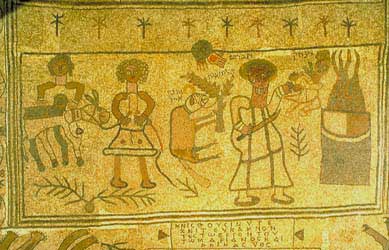
The mosaic floor of the synagogue at Beit Alpha (VI century A.D.)
Iakov Levi
Hamlet. The Puberty Rite of a Danish Prince and His Companions
Dec. 30, 2004
Last modified Oct. 22, 2005
King. So is it, if thou
knew’st our purposes
Ham.
I see a cherub that sees them. – But,
come; for England! – Farewell, dear mother.
(Hamlet, Act.IV Scene III)
Ernest Jones interpreted Hamlet as a Danish Oedipus
(Hamlet and Oedipus). In his book, he analyzed some aspects
of Shakespeare’s tragedy. The ambivalence of the Oedipus complex and
its conflicts find, indeed, their expression in the tragedy.
However, there is also another psychic situation the
unfolding of which condenses in Hamlet’s story, and that has not been analyzed
in Jones’ brilliant work: the role of the young prince and his two companions,
Rosencrantz and Guildenstern, as protagonists of a scene describing a puberty
rite.
My analysis does not invalidate the one articulated by
Jones, but complements it, because puberty rites are the mechanism through
which, in primitive societies, youngsters who at the threshold of puberty
are experiencing in full force a reactivation of their Oedipal incestuous
and aggressive drives, resolve them undergoing a rite of symbolic death
and resurrection, and eventually identify with the generation of the fathers,
accept their ancestors’ laws, and are granted sexual license.
As pointed by Jones, Hamlet’s Oedipal conflicts are particularly
difficult to resolve, and his story unfolds in a – typical way. Instead
of resolving the Oedipal conundrum through identification with his father,
he is overwhelmed by his conflicts and is induced into a self – destructive
resolution. We can say that his puberty rite is aborted, and he is unable
to consummate his manhood and sexuality like other more successful novices. Henceforth, his heterosexual relationship with Ophelia (as Freud says: "the woman is the prize of the battle") is aborted, too.
The end is a tragedy, and the hero dies, without resurrecting into adulthood.
The role of the servants
In Rosencrantz and Guildenstein, I have tried to
make an interpretation of the latent meaning of Shakespeare’s
two strange imagines.
They come out of the blue, enlisted to the service of
a cruel king, who intended to sacrifice the young prince, sole rightful
heir to the throne of Denmark.
Two servants, similar to Rosencrantz and Guildenstern,
appear out of the blue in Kafka’s story “The Castle”. Out of the blue, quite
non - comprehensive, but still expected, the two servants permeate us with
an uncanny feeling. We know that they should be there, but we don’t know
why and who they are. They are funny, two clowns, but very, very uncanny
and serious. Their joking ways are permeated with the smell of Destiny
and Death.
Hamlet, as Kafka’s protagonist, is the young hero, the
Son, doomed by his father to be sacrificed. The sacrifice of the Son, like
Isaac’s and Jesus’ is unconsciously perceived as atonement and Talion for
archaic death’s wishes towards the Father.
Hamlet is not led to the sacrifice alone, but in the
company of the two servants, who will eventually be sacrificed in his place.
Isaac, too, is not led to the altar alone, but in the
company of two servants, in a similar long journey: “So Abraham rose early
in the morning, saddled his ass, and took two of his young men with him,
and his son Isaac” (Gn. 22:3, ed. Rainbow Missions, Inc).
The specification of the presence of “two young
men” in the context of Isaac’s sacrifice was so puzzling to Rashi that
he felt compelled to explain why Abraham took them with him. Rashi
says: “An important man never engage in a journey alone, but with two men,
because if one of his servants leaves because of his body – needs, the
second stays with him”. It is an obvious rationalization, which nevertheless points at the uncanny feeling associated with the sudden appearance of the two.
The ass is equivalent to Hamlet’s ship. Camels are said:
“the ship of the desert”. At the time of Abraham, camels were still not
domestic animals (see: William F.Albright, The Biblical Period from Abraham to Ezra, Anchor, New York 1963, p.47). Therefore, the text is compelled to use an ass (the story on
the servant of Abraham and his camels in Genesis 24:11-20 is an anachronistic
paragraph inserted into the text by a later editor).
Rosencrantz and Guildenstern are eventually sacrificed
in place of Hamlet, and a ram is sacrificed in the place of Isaac. However,
it seems to me that the original version in both stories was slightly different.
In the Bible is written: “On the third day Abraham lifted up his eyes and
saw the place afar off. Then Abraham said to his young men, ‘Stay here
with the ass; I and the lad will go yonder and worship, and come again
to you’” (Gn. 22:4). If the text, which is otherwise very concise,
specifies that the “two young men ...Stay here”, it means that another possibility,
opposite to the manifest one, had been unconsciously conceived. The two
servants were originally supposed to be sacrificed with Isaac. As Theodor
Reik has shown in The Temptation (1961), the biblical story of Isaac’s
sacrifice contains mnemonic traces of archaic puberty rites, in which a
group of novices are symbolically killed (sacrificed) together.
Indeed the text uses the word Ne‘arim (young men)
and not ‘Avadim (‘Eved = servant) like in Genesis 24
dealing with “the servant of Abraham”. Ne‘arim are youngsters, companions
of Isaac in his puberty rite. Therefore, they were supposed to undergo
the rite of death – sacrifice in his companionship.

1036: Our hastie sending, something
have you heard
1037: Of Hamlets transformation,
so call it,
1038: Sith nor th'exterior, nor
the inward man
1039: Resembles that it was, what
it should be,
It is the "transformation", which had taken place in Hamlet, namely his pubertal needs that are activating the childish aggressive and incestuous drives, “his madness”, that urged the puberty rite, of which death and resurrection are a pivotal part.
In Pinocchio. The Puberty Rite of a Puppet, par.4, I have explained the suffering and Crucifixion
of Jesus as a puberty rite. Jesus was sacrificed in the company of the
two robbers: “Then two robbers were crucified with
him, one on the right and one on the left” (Matt. 27:38).
Luke broadens the scope saying: “Two
others also, who were criminals, were led away to be put to death with
him. And when they came to the place which is called The Skull, there they
crucified him, and the criminals, one on the right and one on the left”
(23:32). "Criminals" means: "filled with incestuous and parricide drives". These are the original crimes, from which all the others derive. John specifies: “There they crucified him,
and with him two others, one on either side, and Jesus between them” (19:18)
Shakespeare, the Genesis’ editor, and the Gospels, present
to us similar versions of the same story: the sacrificed son is led to
his death in the company of two.
Pinocchio too, whose story I have interpreted as a puberty
rite, undergoes threats and tortures in the company of two friends: Harlequin
and Punchinello:
As soon as the play was over the showman went into the kitchen where a fine sheep, preparing for his supper, was turning slowly on the spit in front of the fire. As there was not enough wood to finish roasting and browning it, he called Harlequin and Punchinello, and said to them: "Bring that puppet here: you will find him hanging on a nail. It seems to me that he is made of very dry wood, and I am sure that if he was thrown on the fire he would make a beautiful blaze for the roast". At first Harlequin and Punchinello hesitated; but appalled by a severe glance from their master, they obeyed. In a short time they returned to the kitchen carrying poor Pinocchio, who was wriggling like an eel taken out of water, and screaming desperately: "Papa! papa! Save me! I will not die, I will not die!" (Carlo Collodi, Pinocchio, Chap. X).
The Mother
As I have shown in Pinocchio, in puberty rites of savages, the young novices are taken away from their mothers and sisters, in order to be threatened, tortured, instructed on the laws of the clan, and symbolically killed.
Ham. I see a
cherub that sees them. – But,
come; for England! – Farewell, dear mother.
(Hamlet, Act. IV, Scene III)
They must take part from the women, who cry because they
are told by the men of the tribe that they will never see again their sons
and brothers.
Commenting on Sarah’ death, Rashi says that she died
of grief because she had been told that Isaac had been killed.
In paintings, the women are described in their desperation
at the foot of the Cross, below Jesus’ body, or after the deposition
In Pinocchio:
Here lies
the child with the
blue hair who
died from sorrow
because she was abandoned
by her little brother
Pinocchio (C.Collodi op.cit.
Chap. XXIII).
In all the afore mentioned cases, the women must disappear.
The ship
In Rosencrantz and Guildenstern, I have compared the ship,
which brought the young prince to England – the place where he was supposed
to be sacrificed - to the Sacred Ark of the Israelites in the desert and
to the sacred Egyptian Boat that had been carrying the dead Pharaoh to
the other side of the Nile.
The Pharaoh was the incarnation of Horus, a Son – god,
who after his death reunited with Osiris the Father – god, and condensed
with him, as it is the case with Jesus, who after his death ascends to
Heaven and condenses with the Father. Through his sacrifice, Jesus consummates
the reconciliation between Father and Sons.
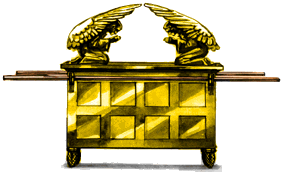
Nile boat with two sailors, Dyn. 11
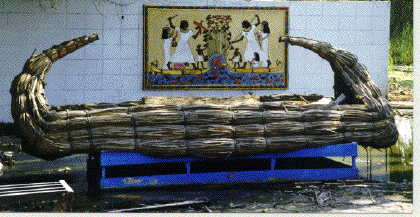
Two Cherubs on the Sacred Ark are equivalent to the “two
young men” of Isaac and Abraham’s story, to the two robbers at the side
of the Cross, to Rosencrantz and Guildenstern, to Harlequin and Punchinello
in Pinocchio, and to the two servants in Kafka’s “The Castle”.
Also in another of Shakespeare's stories, Much Ado about Nothing, there are two clowns, Conrade and Borachio, who appear out of the blue, and have no real meaning, besides the unconscious one. They, too, are "servants", and are entrusted with a strange task, in this case slandering a lady (whose name not casually is Hero, daughter to Leonato), and causing her fall. A slightly different task from the one entrusted to Rosencrantz and Guildenstern. In both cases we are dealing with a fall, to be caused by treacherous ways. In this version of the saga, the hero has been displaced by Shakespeare from a "young prince" into a "heroine", but the real substance of the persona is disclosed by the name itself (Hero).
Conrade and Borachio are called "malefactors" by the Sexton judging their case (Act.IV, Scene II), as "criminals" were called by Luke the two robbers crucified together with Jesus. Furthermore, the farce - trial of the two, described by Shakespeare in a jokingly way, is very similar in its spirit to the one depicted by Collodi in Pinocchio (Chapter XIX), that I have compared to Jesus' farce - trial.
The young novices, filled with incestuous and murderous drives are, indeed, unconsciously perceived as robbers, criminals and thieves. Their instinctual drive is to kill the Father and to still the woman: to our unconscious they are all guilty.
In Much Ado about Nothing, there have been some displacements, from the hero to the heroine (Hero, daughter to Leonato), and from the subject of the trial, which should have been the hero (Jesus, Pinocchio), to the two servants. Moreover, the woman, who originally was the object of the criminal (incestuous) drive, appears in the play as the alleged culprit. It is an interesting displacement, but also a condensation of the object of the incestuous drive with the drive, and its punishment. Of course, she is eventually cleared from the accuses, as we know that every hero should be. We know that Hamlet is not guilty, and so Jesus, Pinocchio etc. After all, we all identify with the young novice, and we root for him.
In works of art, as in dreams, displacements and condensations are a very common device, the purpose of which is to disclose a hidden truth pressuring from our unconscious for recognition, and, at the same time, to conceal it from our consciousness.
The two, they all are
the “servants”, whose original task was to accompany the young hero to his symbolical death and resurrection.
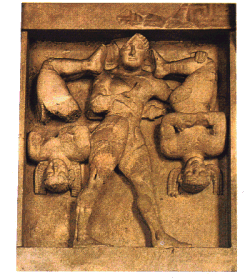
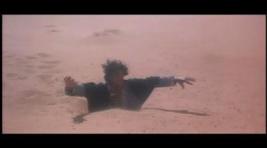
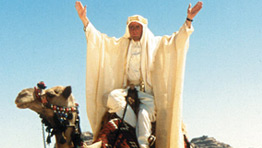
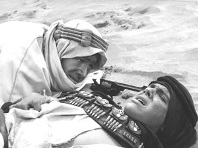
In Jewish monotheistic religion, the image of the Prince – Son God has
been repressed, but it emerges in the figure of Moses, to whom the order
of building the Ark has been given. Before the Babylonian Exile, the image
of Moses was that of a savior Son – God, like Horus (the Pharaoh) and Jesus.
After the Exile, his figure has been elaborated as that of Vicar of the
Father.
The Lord commands to Moses:
You shall make two cherubim of hammered gold. You shall make them at the two ends of the mercy seat. Make one cherub at the one end, and one cherub at the other end. You shall make the cherubim on its two ends of one piece with the mercy seat. The cherubim shall spread out their wings upward, covering the mercy seat with their wings, with their faces toward one another. The faces of the cherubim shall be toward the mercy seat. You shall put the mercy seat on top of the ark, and in the ark you shall put the testimony that I will give you. There I will meet with you, and I will tell you from above the mercy seat, from between the two cherubim which are on the ark of the testimony, all that I command you for the children of Israel. (Ex. 25:18-22).Now, in the post – Exile elaboration, Jahveh himself is “between the two cherubim”, but in the original version, it had been the task of Moses, the young hero equivalent to Isaac, Jesus, Hamlet, and Pinocchio, to stand “on the ship” between two companions; as is said of Jesus: “One on the left and one on the right”.
One day, when Moses had grown up, he went out to his people and looked on their burdens; and he saw an Egyptian beating a Hebrew, one of his people. He looked this way and that, and seeing no one, he killed the Egyptian and hid him in the sand (Ex. 2:11 –12).The text says that he had grown up, meaning, he reached the age of puberty, like Hamlet and the internal changes due to his “madness”. As in puberty rites of savages, he kills the enemy. The bravery act is repeated in the following verses, where the women appears too, to be saved by the hero:
Now the priest of Midian had seven daughters; and they came and drew water, and filled the troughs to water their father’s flock. The shepherds came and drove then away; but Moses stood up and helped them, and watered their flock (Ex. 2:16 -17).Seven daughters. Seven is a sacred number, associated with the number of novices which must be gathered in order to perform the rite (seven are also the stages in the puberty rites of Mithra's cult). Subsequently, Moses chooses one of them as his bride (Ex. 2:21). Cf. Jacob's heroic deed at the well, after which he "kisses" Rachel (Gn. 29: 1-11).
Now, to the latent meaning of the Sacred Ark.
The Virgin and the Sacred Ark
As Freud has shown, a box is the symbol of the woman ("The Theme of the Three Caskets", 1913; "Symbolism in dreams", 1915 - 17).
A ship is the same. Furthermore:
In the Arab village of Abu Gosh, a few miles West of Jerusalem,
stands a beautiful church (Emmaus des Crois�s, Monast�re de la R�surrection),
dating back to the Crusaders’ period, erected on the biblical site of Kiryat
Yearim, which is traditionally held to be the place where the Ark of the
Covenant stayed for 20 years before David took it to Jerusalem (1 Samuel
6:21-7:2).
The Benedictine monks who dwell in the place show to the visitors a big
painting dating from the 19th century, which covers the entire wall in
front of the altar. The painting represents the Virgin and the sacred Ark,
and the monks explain that its relevancy to the place consists in the symbolic
continuity between the Ark of the Covenant and the Virgin. The former does
not exist anymore, and the latter has taken its place, namely, the Ark
and the Virgin Mary are equivalent.
Therefore, the primal “Mother Goddess” mentioned by Freud
is the Ark, which, being a container, a shrine (like the Temple) is the
symbol of the Mother.
Since ships are also a female symbol (Symbolism in Dreams", op.cit), we have repetitions
of the same thing. As stated by Theodor Reik: "the unconscious behaves like the ancient languages. Both express the importance and significance of a process by means of repetition" (The Puberty Rites of Savages", in Ritual, Farrar & Straus, New York 1946, p.140).
In the story of Joshua and the two spies, the woman is repeated, too: Rahab, the prostitute, and Jericho and her walls (see Rapunzel and Other Stories of Beautiful Hair).
In the Bible, the ultimate woman - prize of the battle is the whole body of the Mother: The Promised Land.
In Isaac’s story: Sarah and the donkey. The altar too,
which is a stone, might be interpreted as male or female, according to
the context (Cf. Myth and the Cloacal Theory). Reik has interpreted altars,
which are made of stone, as the god himself (Theodor Reik, "The Shofar" in Ritual, Psycho-Analytic Studies, Farrar & Straus, New York 1946, pp. 309-361; Cf. Killing God), but since the primal divinity is always the Mother, as exposited
by Freud, we may infer that the altar as God the Father is a concomitant or later stage,
and condenses with the more archaic layer.
In the context of the Exodus: the Ark, and the Tablets
of the Law that it contains (the Law – Torah is the Mother, as I have shown
in On Trees and on Birds (and on Flowers).
In Hamlet: the mother, and the ship, and England (countries
are female symbols, as Freud has shown in "Symbolism in Dreams", op.cit.) as he said: “I see a cherub that
sees them. – But, come; for England! – Farewell, dear mother."
(Hamlet, Act. IV, Scene III) .
In the Gospels, there are several repetitions too: The
Virgin, the ass on which Jesus rides on Palm Sunday, and also the Cross.
The Cross is the Tree of Life. Henceforth, it has a female connotation
(Cf. On Trees and on Birds (and on Flowers)). Jesus sacrificed on the Cross is equivalent
to Isaac sacrificed on an altar, reinforcing my interpretation of
altars as a condensation of male and female symbols, Goddess and God.
Furthermore, Jesus carrying the Cross, in his long stressful
journey to the Calvary, is an inversion of the original situation: He is
riding the Cross, and not the other way around. Inversions are very common
in dreams, myths, and artistic representations.
Pinocchio, on his way to his own puberty rite, rides a Pigeon ( Chapter XXIII), which, being a bird, is the symbol of the penis, male or female, according to the context.
As we have seen, Isaac, Hamlet, Jesus, and other young heroes passing through their puberty rite of death and resurrection, embark in a journey, at the climax of which they are supposed to be sacrificed.
In our unconscious, as it is in dream symbolism, a journey symbolizes death. It seems to me that the symbolism of a journey as "death" is engendered in the archaic puberty rites of mankind, and unconsciously transmitted from generation to generation through the phylogenic vehicle. Freud himself suggested that symbols are transmitted through inheritance.
As the French still say: "Partir c'est un peu mourir". At the origin of every idiom and manner of speech there is always a very concrete meaning. Only later, after the original content has been repressed and forgotten, we overlay on it a metaphorical sense. Originally, Partir meant �to be sacrificed�.
The deepest layer
We have seen that all the afore mentioned stories contain
mnemonic traces of archaic puberty rites. A young hero is led to the sacrifice,
riding the symbol of the maternal body, in the companionship of two other
young men.
It remains to fully understand why his companions are
always two. As in the case of Jesus, is even more specifically said that the hero stands between the two: “One
on the right and one on the left” (Matthew);
“There they crucified him,
and with him two others, one on either side, and Jesus between them” (John)
.
We have seen that, like Jesus, who stands between the
two robbers, Jahveh stands, in the same way, between the two cherubs:
“You shall make two cherubim of hammered gold. You shall make them at the
two ends of the mercy seat. Make one cherub at the one end,
and one cherub at the other end” (Ex. 25:18- 19).
But the text says something more: the cherubs, in the
middle of which Jahveh stands on the Ark, are made of hammered gold. The
association between cherubs and preciousness emerges also in the following
verses:
Moreover you shall make the tent with ten curtains; of fine twined linen, and blue, and purple, and scarlet, with cherubim. The work of the skillful workman you shall make them (Ex. 26:1)As Freud has shown in Symbolism in Dreams (1915 - 17), jewels and preciousness are the symbols of the female genital. A cherub is indeed a precious stone. Therefore, the two precious cherubs are females.
"You shall make a veil of blue, and purple, and scarlet, and fine twined linen, with cherubim. The work of the skillful workman shall it be made. [32] You shall hang it on four pillars of acacia overlaid with gold; their hooks shall be of gold, on four sockets of silver. (Ex. 26: 31- 32)
As I have mentioned in Rosencrantz and Guildenstern, the
two companions of Hamlets are females too:
For Rosen – crantz, Shakespeare himself told us
what it means::
“For women are as roses, whose
fair flower, Being
once displayed doth fall that very
hour”.
(Twelfth Night, Act II, scene 4).
And Schiller confirms: �Honor women! With roses grown in Eden�s bowers They intertwine this life of ours�
Rosen-crantz is, therefore, a rose, namely, a female.
Moreover, Freud has shown that flowers are the symbol
of virginity ("Symbolism in Dreams"; Cf. On Trees and on Birds (and on Flowers) )
Furthermore, as we know from the saying, “ There is no
rose without a thorn”,
meaning there is no female without a penis.
And Guilden - stern?
Here we have the preciousness (gold), the guilden, which
was a Dutch coin of gold before being devoured by Mother Europe.
AS Freud has shown (op.cit.) "jewel" and
"precious" are symbols of the female genital .
How it occurred that at a deep unconscious level, the
two young companions, who are to sort part with the destiny of the young
hero, and are led with him to the sacrifice, are conceived as having a
female connotation?
At this deepest unconscious level, who is the novice,
the young hero who must die and resurrect?
As shown by Jones, Hamlet is Oedipus, and so are all
the novices who are taken into the bush by their fathers in order to be
symbolically sacrificed. Eventually they are circumsized, sacrificing part
of their genital, on behalf of themselves: a part of the genital as symbol
of their all body. The aim of the rite is to exorcize the incestuous and
aggressive drives which, during puberty, are activated again due to the
new hormonal excitement of the flesh, and become dangerous to social order
and survival of the clan. Indeed, the drive to be exorcised and channeled
is felt in the genital. As I have shown in Pinocchio, the nose to be cut
down is the erected penis. This is the member, which must be sacrificed.
In our unconscious, the penis is the pars pro toto (a part for the
whole) of its owner (2). A penis, which must be sacrificed, is the novice himself.
If the hero led to the sacrifice is the penis, his companions
are unconsciously perceived as his two testicles. This is the reason why
they are always two.
Why they are also perceived as having a female connotation?
A testicle is rounded. As we vulgarly say, it is a ball.
A ball is female (Cf. Soccer Games and Caravaggio). Henceforth, the
male genital is perceived as being composed by the erecting penis (masculine
component) and two balls (feminine part). It might also be that the reason why the number 3 is the symbol of the male genital is that it is, indeed, composed by three parts.
Furthermore, the little child, while he urinates, is
convinced that the testicles are the container of the urine. He is induced
into this childish thinking by the proximity of the testicles to the penis.
He must make to himself a reason of that proximity. He still knows nothing
of testicles as containers of sperm. As we already know, containers are
female symbols.
Now we know why the hero’s companions are always two,
and by a female connotation, and “one on the right and one on the left”.

Freud and Rank have wondered on the uncanny aspect of “the double”:
The theme of the 'double' has been very thoroughly treated by Otto Rank (1914). He has gone into the connections, which the 'double' has with reflections in mirrors, with shadows, with guardian spirits, with the belief in the soul and with the fear of death; but he also lets in a flood of light on the surprising evolution of the idea. For the 'double' was originally an insurance against the destruction of the ego, an energetic denial of the power of death', as Rank says; and probably the 'immortal' soul was the first 'double' of the body. This invention of doubling, as a preservation, against extinction has its counterpart in the language of dreams, which is found of representing castration by a doubling or multiplication of a genital symbol. The same desire led the Ancient Egyptians to develop the art of making images of the dead in lasting materials. Such ideas, however, have sprung from the soil of unbounded self-love, from the primary narcissism, which dominates the mind of the child and of primitive man. But when this stage has been surmounted, the 'double' reverses its aspect. From having been an assurance of immortality, it becomes the uncanny harbinger of death. (Sigmund Freud, "The Uncanny”, 14 [1919] )Therefore, the original and most concrete layer refers to “representing castration by a doubling or multiplication of a genital symbol”. Doubling represents death – castration, and only later became also an apotropaic mean against the anxiety triggered by its own representation.
Postscript
Now, we can try to decode a riddle, which has been puzzling me for some time.
On 18 December 1909, Jones writes to Freud: "... in Egyptian phallic worship that the right penis was the Father, the right testicle Horus (Christ) and the left Isis (Maria)" ( The Complete Correspondence of Sigmund Freud and Ernest Jones 1908-1939, Ed. by R. Andrew Paskauskas, The Belknap Press of Harvard University Press Cambridge, Massachusetts and London 1993, p. 35).
If, according to Jones' words, Christ is a testicle, and rounded, he has a female connotation, which is furthermore confirmed by having been paralleled by him to the left testicle, Isis - Maria. It fits also what we know about the left side, which is the side of the mother, and the right side, which is the side of the Father.
It represents an apparent contradiction to what I have sustained, so far, that the Christ, like Hamlet, is the young hero, and therefore he is male in his substance. He is the penis, led to the altar for being sacrificed - killed - castrated.
I had already stumbled into this contradiction, when I compared the crucified Christ to a serpent (Medusa, the Female Genital and the Nazis). The Gospel itself had drawn the equivalence: "And as Moses lifted up the serpent in the wilderness, so must the Son of man be lifted up, that whoever believes in him may have eternal life" (John, 3:14).
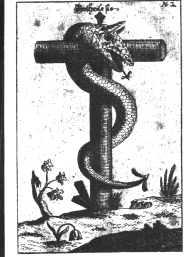
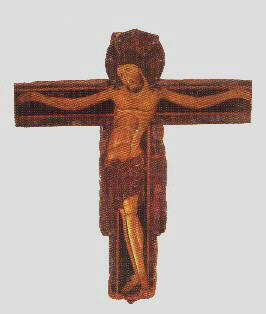
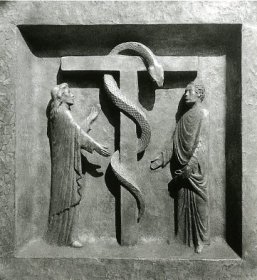
As I have shown in Why Is the Lady so Sexy?, and in Medusa, the Female Genital and the Nazis, the serpent is the symbol of the fantasized female penis.
However, the contradiction is comprehensive to the ones familiar to libido's transformations in psychoanalysis.
After having been sacrificed, and having resurrected, the Christ ascends to Heaven, and sits Dextera Patris (at the right hand of the Father).
According to Jones' letter, he was the right testicle: been "right", he is male, and being a testicle, he is female. The female connotation is due to his provenience from the Mother. In psychoanalytic processes of transformation, what comes from the Mother has also a female connotation. Christ had been a child procreated from the Mother, and therefore shared her feminine substance.
It also fits parthenogenetic theories of children.
In the process of condensation and identification peculiar to puberty rites, what had belonged to the Mother, now belongs to the Father. After the Resurrection, he identifies with the Father, and sheds his female connotations.
Now we can better understand the condensation of the scene showing the Christ being led to his sacrifice riding an ass on Sunday - Palm, and riding the Cross (inversion of the Cross riding him), on his way to the Calvary. As we have seen, both the ass and the Cross, like Hamlet's ship, and the Ark of the Covenant, are the symbol of the Mother. During the journey to their sacrifice, the young heroes, Isaac, Hamlet, Jesus - Horus etc, prior to their death - resurrection - identification with the fathers, still share the female connotation of being a part of their mother. The journey to the sacrifice represents the stages in puberty rites of savages when the novices are still in the process of initiation, still half - male, half - female. Only with the completion of their rite, they acquire sexual license and a full masculine identity. Now, the feminine connotation of the Christ during the journey, and still on the Cross, becomes clear, and so also Jones' sentence:
"in Egyptian phallic worship that the right penis was the Father, the right testicle Horus (Christ) and the left Isis (Maria)".
Egyptian phallic worship represented no other than the continuation of archaic puberty rites, now transfigured into historical – times religious rites. The protagonists remained the same: the generation of the fathers (the right penis), the young novices (Horus - Christ), who are a young penis (right), by a female connotation (testicle), led to the altar in order to be sacrificed - killed - castrated, and resurrected as full males, and the ship - ass (Isis – Maria).
However, there is another deeper and latent content in the female connotation of the substance of the young hero, before resurrecting and fully identifying with the Father.
Theodor Reik has shown that Christ's wound (John 19:34) "approximate to the mutilation of the penis in the initiation of boys among the primitive peoples ("The Puberty Rites of Savages", in Ritual. Psycho - Analytic Studies, Farrar & Straus, New York 1946, p. 159).
To our unconscious, a wound is not just such, it is a symbol of castration.
Furthermore, as Freud and Abraham have shown, the little child makes an interpretation of sexual intercourse as an aggressive act of castration inflicted on the female by the male (Sigmund Freud, "The History of an Infantile Neurosis", in The Standard Edition of the Complete Works of Sigmund Freud, Ed. and Trans. J. Strachey, Hogarth Press, London 1964, Vol.XVII, pp.121-2; Karl Abraham, "The Female Castration Complex" (1920), in Selected Papers of Karl Abraham, ed. by Ernest Jones, tr. by Douglas Bryan and Alix Strachey, Hogart Press, London 1927, pp. 339 - 343).
With the words of Abraham: "The female genital is looked upon as a wound, and as such it represents an effect of castration" (K.Abraham, op.cit., p.340).
Now we can understand the deeper unconscious meaning of mutilations, as circumcision or other equivalent castration symbols, inflicted on the novices during initiation rites by the generation of the fathers. By mutilating the novices, the fathers also "make them females".
The heroes, who display proudly their wounds, symbols of the struggle they had to endure with the Father, are also displaying their female genital. Peoples are emotionally aroused in seeing in that wound the sign of heroship. The hero, who, as Freud says "was a man who by himself had slain the father" (Group Psychology and the Analysis of the Ego (1921), Chap. XII(B) ) is also the one who carries in the flesh the mark of that deadly struggle.
Oedipus had "inflated legs". Jacob limps after his struggle with the angel, interpreted by Reik as the mnemonic trace of an injury suffered during a puberty rite ("The Wrestling of Jacob", in Dogma and Compulsion, International Universities Press, New York 1951, pp. 229-251). In Pinocchio, Oedipus' "inflated legs", and Jacob's "limping", are represented by the burning of the puppet's feet. Geppetto, the father, is the one who restores them again (C.Collodi, Pinocchio, Chap. VII. Cf. [15]). Moshe Dayan proudly displayed his patch, and his soldiers just adored him, because of that patch. Pirates usually display a patch on an eye, which bears a strong connotation of bravery and defiance: popular fantasy gets excited at that sign of an archaic struggle against the primal Father.
Abraham has shown that the eye is a penis substitute [21] , as is the case in Oedipus' story (Cf. Truth Is a Woman: Bernini - Giorgione - Manet). A castrated eye is, therefore, equivalent to a castrated penis. As I have shown in Zoppi e altri mutilati, a true hero must display a sign of lameness.
As the precondition for successfully overcoming the puberty rites, and obtaining sexual license and manhood, is to die and to resurrect, so is the stage of temporarily becoming a female, by a wound, symbol of the female genital.
Now we can better understand the female connotation of novices and heroes.
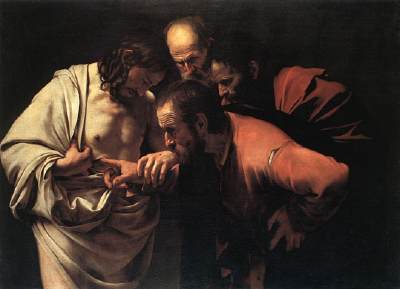
Jesus displays the wound in his side. It is the ultimate evidence that he had successfully passed his puberty rite. Therefore, it was so important that his disciples, who represent the Brotherhood Horde, believe that it is there. Even Thomas, the disbeliever, now knows it.
Death is equivalent to castration. Therefore, the dead Christ is a female, as we can see in Il Cristo morto, Chapel of Sansevero, Naples (Cf. The crucified Christ in the church of the monastery of San Lorenzo de El Escorial, Spain)
Resurrection is equivalent to erection (3): The resurrected Christ is fully masculine, as we can see in the painting by Piero della Francesca.
Through many representations, artists deliver to us the unconscious substance of the Death and Resurrection. Michelangelo carved in wood a crucified Christ, whose body is that of an eight to ten years old child, quite feminine, like that of many young children, kidnapped by their fathers in order to undergo the puberty rite (Church of Santo Spirito in Florence). Oddly, he also has a beard. The representation is an obvious condensation, otherwise incomprehensible, of the child led to his death, still feminine, and of a bearded lad, after his successful rite has been completed. The same artist sculptured in marble also a resurrected Christ, who represents a young hero fiercely holding the cross as a sword (Santa Maria Sopra Minerva, in Rome), and who reminds his very David. Instead of David's sling, the Christ holds the cross.
The Christ rising from the sepulchre, who represents an erecting penis, is equivalent to Jahveh rising on the Sacred Ark, as we mentioned before. As is written: "It happened, when the ark set forward, that Moses said, Rise up, Yahweh, and let your enemies be scattered; and let those who hate you flee before you." (Numbers 10:35).
As the Christ, who in his manifest erection is a penis, in a full condensation with the Father, as it occurs as a completion of his puberty rite, so Moses and Jahveh, the Son God and God the Father condense in a unique entity rising from the Ark. It is not casual that the context is: "when the ark set forward", namely during a journey, as the journey of Isaac, Jesus, and Hamlet to their sacrifice. As usual, the Hebrew biblical version is much more condensed than the Christian version, because the Jews, after the Babylonian exile, at the time of the edition of the biblical text, were eager to conceal the previous existence of two gods: A Son God (Moses), and a Father God (Jahveh).
We have a condensation of more than one stage: 1) The penis is led to his sacrifice because of the erection, namely the erection of the Son. 2) After the sacrifice - atonement, the erection of the Son condenses with the erection of the Father. This is the final stage of identification and sexual
license.
In Piero della Francesca's painting, we still see the Christ - erection as an act of defiance toward the Father. However, in the process of ascending to Heaven, the defiance transfigures into the compromise of identification. Indeed, immediately after rising from the sepulchre, Jesus still was not allowed to touch the woman, until he ascends to the Father. As is written: Jesus said to her, "Don't touch me, for I haven't yet ascended to my Father; but go to my brothers, and tell them, 'I am ascending to my Father and your Father, to my God and your God.'" (John 20:17. Cf. Jesus and Mary Magdalene, the Harlot of the Horde)
"Don't touch me" (Noli me tangere). He was not yet allowed to have the woman, because he had not yet completed his puberty rite by the process of identification with the Father. Hamlet, too, was not able to possess Ophelia, because he had not yet completed his own rite of identification. Eventually, the Christ ascends to the Father and becomes a successful novice, while Hamlet aborts his own puberty rite. Henceforth, he aborted his relationship with the girl, too.
The Rebels: Robin Hood and Zorro
"Bless me, even me also, my father." ...
Don't think that I came to send peace on the earth. I didn't come to send peace, but a sword. For I came to set a man at odds against his father, and a daughter against her mother, and a daughter-in-law against her mother-in-law. A man's foes will be those of his own household. He who loves father or mother more than me is not worthy of me; and he who loves son or daughter more than me isn't worthy of me" (Matthew 10:34 -7).
As I have sustained in Pinocchio. The Puberty Rite of a Puppet, in Jesus and Mary Magdalene, and in Rembrandt and the Prodigal Son, Jesus represents the unconscious image of the youngest son of the Primal Horde, who becomes the leader of the destitute brothers, and their vicar in the struggle against the oppressive Father.
Two popular folk heroes are named Robin Hood and Zorro. The two, like the Christ, are perceived as the defenders of the poor and the destitute. The all Sermon on the Mountain ( Matthew 5) is an apology of the humble and the persecuted. Robin Hood and Zorro are the rebels and the arrogant young leaders of the Horde, vis a vis the abuses of an omnipotent Father - imago.
They steal from the rich, whom they hate. As Jesus said: "It is easier for a camel to go through a needle's eye than for a rich man to enter into the Kingdom of God." (Mark 10:25) They give to the poor, very similar to Jesus' deeds and teachings: "He commanded the multitudes to sit down on the grass; and he took the five loaves and the two fish, and looking up to heaven, he blessed, broke and gave the loaves to the disciples, and the disciples gave to the multitudes" (Matthew 14:19); "They all ate, and were filled. They took up seven baskets full of the broken pieces that were left over. Those who ate were four thousand men, besides women and children" (Matt. 15:37 - 8); "Jesus said to him, 'If you want to be perfect, go, sell what you have, and give to the poor, and you will have treasure in heaven; and come, follow me.'" (Matt 19:21)
They are against the institutions, which are perceived as oppressing, hypocrite, and unjust, something like the Pharisees in the Gospels.
As we know, "Robin" means "fox". "Zorro" is the same, in Spanish.
As we know from tales and folk sayings, the most evident peculiarity of the fox is craftiness. It is some sort of wisdom, which is more than wisdom, and is an essential device, in order to be able to defeat a physically stronger enemy: the Father. As crafty had to be David, in order to defeat Goliath. It fits what Freud has said of the hero, the youngest and smartest son of the Horde, who will be the leader of the rebels’ band: "For we often find in them that the hero who has to carry out some difficult task (usually the youngest son, and not infrequently one
who has represented himself to the father-substitute as being stupid, that
is to say, harmless)" (Group Psychology and the Analysis of the Ego(1921) Chap. XII (B) ). Pretending to be stupid is something that only a very smart person can do. Indeed, Zorro had a cover up image of a harmless and cowardly gentleman. The same are Superman - Clark Kent, Batman - Bruce Wayne, and Spiderman - Peter Parker, the American folk - heroes. They all are astute and strong, while pretending to be meek and harmless. Jesus, too, warns his disciples to be astute, but to pretend to be meek and harmless: "Therefore be wise as serpents, and harmless as doves. But beware of men: for they will deliver you up to councils, and in their synagogues they will scourge you" ( Matthew 10:16 - 17).
All represented himself to the father-substitute as being stupid, but were indeed very, very smart.
Batman has also a younger "servant", who is his own repetition and confirmation, and whose name is Robin, not casually, for sure. Repetitions mean confirmation. The unconscious message is that if you did not completely grasp it the first time, now you have another hint. The reason is that an emotional content (drive - need), which has been repressed, pressures for recognition from the underworld in which it has been relegated.
They are young heroes, fighting for social justice, and represent a paramount threat to evildoers of all kind, just like Jesus.
Americans love to think that their own society is the right and just one (who knows? They might well be right), and, therefore, American folk - heroes do not fight their own institutions, like Robin Hood, Zorro and Jesus, but the "wrongdoing" is displaced into common criminals.
Superman, Batman, and Robin are flying creatures. Therefore, they represent phallic symbols, like angels and birds, which might be masculine or feminine, according to the context. Moreover, they are saving - phallic creatures, confirming to us the phallic nature of the Savior. In The Pied Piper of Hamelin, I have explained rats as symbols of the penis, in that context by the feminine substance. Bats are flying rats. The penis symbolism is even more evident.
Furthermore, angels, who are the doers of the Father's will, and are his erection and extension, are half male - half female. As is written: "They stand on one single leg", and the Rabbis explain: "They have no sex, therefore they cannot have two legs, because the substance of the sex is between the legs".
Having no sex is unconsciously equivalent to having both sexes. In our unconscious, there cannot be a vacuum, a non - thing.
Even more interesting, is the phallic symbolism of Spiderman. He is a spider, and, as Abraham has shown, a spider is the symbol of the female genital ("The Spider as a Dream Symbol" (1922), in Selected Papers of Karl Abraham, Hogarth Press, London 1927, pp. 326-332)
As Robin Hood and Zorro, the astute foxes, as the American folk - heroes, and as the hero mentioned by Freud, Jesus was a smart young man, too: "and all who heard him were amazed at his understanding and his answers" (Luke 2:47); "It happened, when Jesus had finished saying these things, that the multitudes were astonished at his teaching." (Matthew 7:28)
In Pinocchio. The Puberty Rite of a Puppet, par.3, I have interpreted the figures of the Fox and of the Cat, as females. Both because of the their dense furs, symbol of the pubic hair. The Cat, more specifically, is the symbol of the vagina.
Moreover, "craftiness", the peculiarity of the fox, is also associated with the serpent, as is written: "Now the serpent was craftier than all the beasts of the field which the Lord God had made" (Gen., 3:1). And the serpent is the symbol of the missing female penis.
Robin Hood - Zorro, the fox, like the others, is the pubertal hero, strong and masculine, but also with a female connotation (4).
Now we know why. The young hero, vicar of the oppressed Brotherhood Horde against the paternal abuses, while wandering as a bandit outside the main camp, has a female connotation, too.
I have shown the equivalence between the context of puberty rites, and the context of the existential conditions of the Primal Horde in Pinocchio. The Puberty Rite of a Puppet, par.2:
When the youths were kidnapped by the fathers, separated from their mothers and sisters, compelled to live isolated and in small groups, under the constant threat of castration by their fathers, the situation triggered also a reactivating of the psychological contents peculiar to the primeval horde, described by Freud. At this point, we have also the correlation between the Prodigal Son, the youngest son, who returns home delegated by the rest of the horde to kill the Father (like in the primeval horde), and eventually acts out a reconciliation instead than a murder (like in the puberty rites). Those rites had, in this way, the purpose of staging again the primary event but, at the same time, of acting out its undoing through the different outcome: reconciliation instead of a murder.
The psychological aspect of puberty rites and its meaning
"Haven't you reserved a blessing for me?" (Gen. 27:34-37)
In our Western culture, we don't perform puberty rites anymore, as these had fallen into oblivion at the dawn of our civilization. However, the psychological needs, which are at the root of those rites, are still there.
As we have seen, they continued to emerge from the repression in the rites of later religions, and even in playwrights, in tales, in folk - heroes' stories, and in works of art.
As we have seen, the puberty rites of primitive peoples were composed by stages. Those same stages are no more acted out in carne (in the flesh), but are part of the psychological evolution a child has to pass through, in order to become a healthy adult.
With puberty, biological evolution finally caches up with the psychosexual evolution, which had been completed at the age of four or five. Now the child is confronted again with the same erotic and aggressive excitements of his early infancy, but this time he experiences them in the flesh, with the intensity of a teenager. Now, those drives are perceived dangerous to himself and to society.
The only way he has to successfully overcome the internal conflicts is identifying with the parent of the same sex. However, it is a very complex endeavor, composed by several stages. In this context, I shall focus only on boys.
First, the boy feels threatened by his father. The castration fears of early infancy are activated again by his genital urges. In the unconscious, there is no difference between fantasies and acts. So, in this stage, the boy dreads of being castrated by his father. Self - castration is the only way of lowering the anxiety's tension of being actually castrated by his father. In the same condensation, self - castrating is also a device for resolving the dangerous genital urge directed at the mother. In this stage, he actually becomes a female, he identifies with the mother, and, as such, he craves for the father as a female. His pre - Oedipal homosexual drives are activated again by the self - imposed inhibition towards the mother (the novices are separated from the women), and the paternal threats induce him into a passive homosexual position (the Christ shows his wound - the Christ craves for the Father: "My God, my God, why hast thou forsaken me?"[Matt. 27:46]).
Henceforth, the female connotation that we have encountered in all our heroes. This female connotation, namely identifying with the mother, reaches its peak in the stage in which the novice is sacrificed on the altar, which is concomitant to the peak in the adults' threats.
The sacrifice - castration of the novice is immediately subsequent to the erection, and is therefore unconsciously interpreted as its consequence and punishment. The erection is represented by the motion inherent to the journey: riding the ass (Isaac), riding the Sacred Ark (Jahveh - Moses), riding the ass and the Cross (Jesus), departing by the ship (Hamlet). All riding the symbol of the Mother (the vehicle) and being sacrificed on the symbol of the Mother (the Cross - the altar - England). "Riding" condenses also the equivalence of "erection". Henceforth, riding motorbikes (modern asses) has a strong connotation of virility, and bikes are the preferred vehicle of pubertal gangs. Moreover, every "riding" is associated with an euphoric feeling: erection - euphoria - heroic deed are concomitant and condense in the same representation, from the Prince Charming of the tales to The Chariot of the Sun and the Messiah.
Back to altars and countries. It seems to me that "altar" condenses Mother and Father.
"Country" in some languages is called "Fatherland", and in some languages is called "Motherland". Therefore, it might be that also "Country" condenses both, at least in some degree of the libido's distribution. However, usually in "countries", and "cities", the emphasis is on the female connotation, as stated also by Freud ("Symbolism in Dreams", op.cit.). In the Bible, cities are specifically called "daughters" and "women":
Manasseh had in Issachar and in Asher Beth - shean and its towns (in Hebrew "Bnoteah" = "her daughters"), and Ibleam and its towns (Bnoteah), and the inhabitants of Dor and its towns (Bnoteah), and the inhabitants of En-dor and its towns (Bnoteah), and the inhabitants of Taanach and its towns (Bnoteah), and the inhabitants of Megiddo and its towns (Bnoteah), even the three heights. ( Joshua 17:11)
And "mother", "daughters" and "sisters". So the prophet addresses Jerusalem:
Behold, everyone who uses proverbs shall use [this] proverb against you, saying, As is the mother, so is her daughter. You are the daughter of your mother, who loathes her husband and her children; and you are the sister of your sisters, who loathed their husbands and their children: your mother was a Hittite, and your father an Amorite
Your elder sister is Samaria, who dwells at your left hand, she and her daughters; and your younger sister, who dwells at your right hand, is Sodom and her daughters. Yet have you not walked in their ways, nor done after their abominations; but, as [if that were] a very little [thing], you were more corrupt than they in all your ways. As I live, says the Lord Yahweh, Sodom your sister has not done, she nor her daughters, as you have done, you and your daughters. Behold, this was the iniquity of your sister Sodom: pride, fullness of bread, and prosperous ease was in her and in her daughters; neither did she strengthen the hand of the poor and needy. (Ezekiel 16:46-9)
And Jerusalem is beautiful as a beloved woman: "You are beautiful, my love, as Tirzah, Lovely as Jerusalem. Awesome as an army with banners." (Canticle 6:5)
Ancient heroes often completed their heroic deed, which is the later trasfiguration of archaic puberty rites, by founding a city (Heracles, Romulus etc), which is equivalent to conquering a city (=a woman). In languages derived from Latin, "Country" is female: French La Patrie and Italian La Patria, and always represented as women. Usually naked women, underlining the lustful content of patriotism. Patrie and Patria are females, but the word itself comes from the Latin Pater (father), namely they come from the Father, they are part of him, and belong to him. They are his extension and erection (cf. The Image of God in Judaism: Father or Mother?).
Therefore, the concept "Fatherland" is to be understood as "the Country is the Mother and she belongs to the Father": Fatherland = the Land of the Father.
The Clich� "God and Country" really means: "Dad and Mom".
After having been symbolically killed - castrated, the novice resurrects. Isaac, like Pinocchio, returns to the main camp in the company of the father, where the women had been waiting in grief, namely the initiated novice walks with the father in full identification: "So Abraham returned to his young men, and they rose up and went together to Beersheba." (Gn. 22:19). As is written of Noah, another novice -hero erecting and resurrecting from the waters: " Noah was a righteous man, blameless among the people of his time. Noah walked with God" (Gn. 6:9). The novices and the fathers are one. The Christ ascends to Heaven, sits Dextera Patris (at the right hand of the Father), and becomes one with the Father. In Christian theology, he even becomes the prominent figure, partially satisfying his aggressive drives towards the paternal image, but nevertheless the Father - imago is there, behind the curtain.
Now, the Oedipal complex conundrum is resolved, but only at one condition: that the father has permitted, encouraged, and even induced the process of identification.
In the puberty rites of savages, the generation of the father secludes the youngsters, threatens them of death - castration, but at the same time the novices are also instructed on the secrets and on the laws of the clan. This is the stage where they are told of the clan's tradition and ethical values. They fully identify with their ancestors, renounce their patricide and incestuous drives, and they are granted sexual license.
At this stage, they are also able to shed their female connotation. Namely, in order to shed the feminine part from their psyche, the young novices need a strong, menacing, but also emphatic, father figure, which induces them into full identification with the paternal sexual identity and his ethical values. At the same time, fathers must feel proud of their sons, as children must be gratified with their fathers' approval. To pubertal boys, feeling their father's approval is of pivotal importance for their sexual identity and mental well - being. At the end of the puberty rite, the generation of the novices and that of the fathers become one by a blood covenant between the two.
Now we can understand why Hamlet failed his own puberty rite. As Jones said, his father's assassination by the uncle had reactivated his own patricide drives. His uncle did what Hamlet himself had craved to do. Henceforth, Hamlet's paralysis in taking action. However, these patricide drives are common to all Oedipal and pubertal children, but, while other novices can overcome these aggressive drives by the process of identification, Hamlet could not, because his father was not there anymore, to teach him, and to induce him into identification with his presence and approval. He was a disapproving ghost. A missing father is an assassinated father with no option of being atoned for and identified with.
The implications are that a pubertal child who has not a strong father - figure to identify with, risks of remaining in the previous stage of passive homosexual identity. He keeps identifying with the mother (she is the only presence to identify with), instead of passing to the next stage. A world with no fathers is a world of children identifying with the mother. Hamlet will never be able to consummate a heterosexual relationship with Ophelia: his puberty rite is aborted under the burden of the sense of guilt, which was never resolved by identification with the paternal image.
For sure, the internal conflicts, which are activated during puberty, are the same that the child had already passed through during early infancy. Therefore, the key to a successful resolution of the Oedipal complex is mainly in the correct psychosexual position the child was able to reach in his early interaction with the parents: craving for the parent of the opposite sex, and identifying with the parent of the same sex. Puberty rites propose the right resolution at the time when the conflicts are activated again by the hormonal excitement that the lads experience again at this stage. This time, leading also to an acceptable social resolution. The correct psychosexual position translates into social harmony.
(1) As Theodor Reik reiterated in The Puberty Rites of
Savages : "The foundation of morality without the active co- operation of the father - generation is unthinkable" (in Ritual - Psychoanalytic Studies, Farrar & Straus, New York 1946, p. 156).
Religions represent the articulation of the collective resolution of the Oedipal tensions of the group. In every group, culture, and people, religious belief unfolds in different ways, according to their different evolution. However, if a compromise between the paternal imago and the Sons is not eventually reached, we don't have a religion, but Nazism, which was the absurd trial of founding a society setting aside the moral standards rooted in the internal imago of the Father (Cf. Freud and Reik: Was
Moses an Egyptian?).
The puberty rites of savages are the breeding ground of civilizations, and when the return in full force of the primal Father found its expression in the monotheistic religions, these reconnected - through a regression - to their original root: the full identification of the Son with the Father. That archaic symbiosis had been somewhat diluted in the polytheistic religions of antiquity, in which the confrontations between the generations was still expressed in the myths of the heroes, from the myth of the Titans to those of Prometheus, Theseus, Heracles, and others.
With the implementation of Jewish monotheism, Moses transfigured into the Vicar of the Father, and the mnemonic traces of earlier confrontations between him and God where clumsily erased. For sure, he had previously been a Son - god, a hero. He was degraded to mortal, and became a "prophet".
Something similar happened to Jesus, but he was able to retain his divine nature. After all, Christianity was implemented in a culture whose polytheistic past was too rich and articulated to be successfully dismissed.
It seems that Islam is the religion which most succesfully repressed the element of confrontation between Father and Sons. It seems to me that the reason is that Arabs, and other peoples who implemented it, where still strongly connected to their tribal past and to the prehistoric events, much more than the Jews, not to mention the culturally rich Greeks - Romans. I have discussed the issue in Why Islamic Terror Now.
(2) On the personification that patients do of the male's penis, Reik writes:
Many women call the penis "he", personifying the male genital organ and attributing to it a life of its own, independent of the man. Some women give the penis a special name. A patient whose husband had the name Charles called his penis "Carlos". Another woman addressed the penis as "Master", thus differentiating "him" from its owner whom she called "Mister" (The Need to Be Loved, Bantam Book, New York 1963, p.256).
(3) In the same book, I encountered an interesting sentence:
Men experience such revivals of old experiences they thought buried long ago and find themselves burning in a fire they had imagined extinguished for many years: The erections they have are resurrections (op.cit., p.131).Now, we can also better understand Freud's induction drawing an equivalence between death and castration. Freud has shown that Eros - impulses (Trieb), equivalent to life conservation, are antithetic to the death urge (Todestrieb), which is the primary impulse, tending to restore again the inorganic condition preceding life. I can add that if death is an urge (Trieb), death anxiety is, as every anxiety, a mechanism of defence against the recurrence of such an urge.
(4) It is not casual that we laugh at the title of Mel Brooks' movie: "Robin Hood: Men in Tights". It is an Uncanny hint to what we had always unconsciously known, i.e. that the young manly hero has also a female substance.
Furthermore, as we know, in every army the new recruits are abused on purpose by the training sergeant, who in a despising way calls them "girls". The young lads who are firstly enlisted in the army are introduced to the psychological mood of the young novices in the bush, who are threatened and abused by the adults, until they are induced into obedience and identification. In the first stage, before becoming initiated adults, the are called "girls".
Links:
The Chariot of the Sun and the Messiah
Pinocchio. The Puberty Rite of a Puppet
Jesus and Mary Magdalene
Rembrandt and the Prodigal Son. On Elder and Youngest Brothers
On Trees and on Birds (and on Flowers)
Soccer Games and Caravaggio
Who Burns the Books?
Cinderella
Superman and the Myth of the Heroes